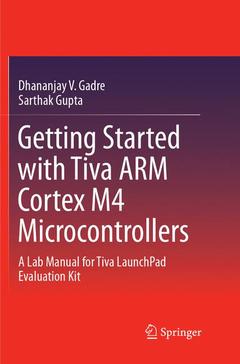Getting Started with Tiva ARM Cortex M4 Microcontrollers, 1st ed. 2018 A Lab Manual for Tiva LaunchPad Evaluation Kit
Langue : Anglais

The book presents laboratory experiments concerning ARM microcontrollers, and discusses the architecture of the Tiva Cortex-M4 ARM microcontrollers from Texas Instruments, describing various ways of programming them. Given the meager peripherals and sensors available on the kit, the authors describe the design of Padma ? a circuit board with a large set of peripherals and sensors that connects to the Tiva Launchpad and exploits the Tiva microcontroller family?s on-chip features. ARM microcontrollers, which are classified as 32-bit devices, are currently the most popular of all microcontrollers. They cover a wide range of applications that extend from traditional 8-bit devices to 32-bit devices. Of the various ARM subfamilies, Cortex-M4 is a middle-level microcontroller that lends itself well to data acquisition and control as well as digital signal manipulation applications. Given the prominence of ARM microcontrollers, it is important that they should be incorporated in academic curriculums. However, there is a lack of up-to-date teaching material ? textbooks and comprehensive laboratory manuals. In this book each of the microcontroller?s resources ? digital input and output, timers and counters, serial communication channels, analog-to-digital conversion, interrupt structure and power management features ? are addressed in a set of more than 70 experiments to help teach a full semester course on these microcontrollers. Beyond these physical interfacing exercises, it describes an inexpensive BoB (break out board) that allows students to learn how to design and build standalone projects, as well a number of illustrative projects.
Introduction.- Chapter 1 ARM Cortex-M4 Core and Tiva C Series Peripherals.- Chapter Tiva C Series LaunchPad.- Chapter 2 PadmaBoard-Peripheral Motherboard of Tiva C Series LaunchPad.- Chapter 3 Tiva C Series Controller Breakout Board(BOB).- Chapter 4 GNU ARM Toolchain.- Chapter 5 Anatomy of C Program.- Chapter 6 Application Programming Interface (API).- Chapter 7 Digital Input/Output.- Chapter 8 Interrupts.- Chapter 9 Timers.- Chapter 10 Universal Asynchronous Receiver and Transmitter (UART).- Chapter 11 Power Management and System Control.- Chapter 12 Analog to Digital Converter(ADC).- Chapter 13 User Input/Output Devices.- Chapter 14 Tiva C Series Based Standalone Projects.
Dhananjay V. Gadre (New Delhi, India) completed his M.Sc. (Electronic Science) from the University of Delhi and M.Engg (Computer Engineering) from the University of Idaho, USA. In his professional career of more than 27 years, he has taught at the SGTB Khalsa College, University of Delhi, worked as a scientific officer at the Inter-University Centre for Astronomy and Astrophysics (IUCAA), Pune, and since 2001, has been with the Electronics and Communication Engineering Division, Netaji Subhas Institute of Technology (NSIT), New Delhi, currently as an Associate Professor. He directs two open access laboratories at NSIT, namely Centre for Electronics Design and Technology (CEDT) and TI Centre for Embedded Product Design (TI-CEPD). Professor Gadre is the author of several professional articles and five books. One of his books has been translated into Chinese and another one into Greek. His recent book “TinyAVR Microcontroller Projects for the Evil Genius”, published by McGraw-Hill International, consists of more than 30 hands-on projects and has been translated into Chinese and Russian. He is a licensed radio amateur with a call sign VU2NOX and hopes to design and build an amateur radio satellite in the near future.
Sarthak Gupta completed his Bachelor of Engineering (Electronics and Communication Engineering) from the Netaji Subhas Institute of Technology (NSIT), Delhi in 2014. During college he worked extensively on embedded systems design using AVR and ARM based microcontrollers. He also worked on reconfigurable hardware like field-programmable gate arrays (FPGAs) and complex programmable logic devices (CPLDs). From June 2013 to May 2014, he worked as a Texas Instruments (India) intern at the TI Centre for Embedded Product Design (TI-CEPD) under the tutelage of ProfessorGadre. From July 2014 to December 2015, he worked at Texas Instruments (India) at their Bangalore office as a design engineer working on the design and verification of
Discusses how to use a low-cost ARM microcontroller kit with a custom peripheral expansion circuit board to augment the capabilities of the Launchpad kit Illustrates programming ARM microcontrollers using two approaches—the direct register access method and the application programming interface functions method Lists more than 75 experiments that can be performed Shows readers how to create their own projects from scratch without using the Launchpad kit, which represents a huge learning step
Date de parution : 09-2018
Ouvrage de 271 p.
15.5x23.5 cm
Date de parution : 10-2017
Ouvrage de 271 p.
15.5x23.5 cm
Thèmes de Getting Started with Tiva ARM Cortex M4 Microcontrollers :
© 2024 LAVOISIER S.A.S.



